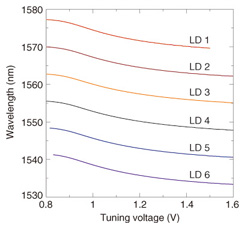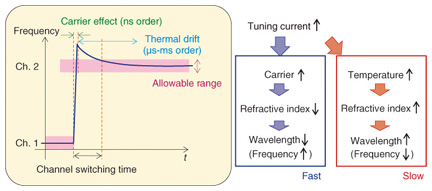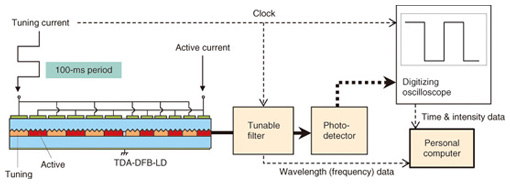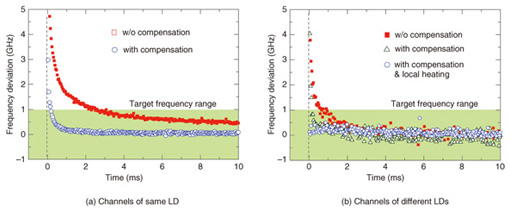 |
|||||||||||||||||||||
|
|
|||||||||||||||||||||
|
Feature Articles: Optical Semiconductor Technologies for Photonic Networks Vol. 10, No. 12, pp. 38–44, Dec. 2012. https://doi.org/10.53829/ntr201212fa6 High-speed Tunable Distributed Amplification Distributed Feedback (TDA-DFB) LasersAbstractIn this article, we describe experimental results and an accurate wavelength control method for tunable distributed amplification distributed feedback (TDA-DFB) lasers, which can offer fast wavelength switching and high controllability because wavelengths can be changed continuously. They should provide light sources for future photonic networks such as wavelength routing systems. 1. IntroductionThe capacity of optical fiber communication networks has increased greatly through the use of wavelength division multiplexing (WDM) systems, where signals with multiple wavelengths are transported in a single fiber. Since signals with different wavelengths do not interfere with each other, they can be separated easily by using an arrayed waveguide grating or other interferometer device. A wavelength routing system has been studied for future photonics network systems, where transmission paths are selected dynamically by using the wavelength of the signal lightwave as destination information. High-speed wavelength switching reduces the amount of data that must be transmitted and makes possible optical switching systems without electrical bandwidth and delay limitations. There is a real need for light sources that can change wavelength quickly and accurately for use in systems that use dynamic wavelength switching. The various tunable wavelength lasers, which can be roughly divided into hybrid and monolithic types, are shown in Fig. 1. The hybrid types consist of both a semiconductor part for gain and other material parts for tuning, so they are also called external cavity lasers. Their wavelengths can be controlled by changing the center wavelength of the external filter or reflector. The tuning speed depends on the response of the external filter or reflector. On the other hand, the monolithic types have gratings or other structures for selecting the wavelength in the semiconductor, and the lasing wavelength is changed by changing the refractive index.
The refractive index of the semiconductor can be changed by changing its temperature, which can be easily and stably controlled with a Peltier device. As a result, a tunable distributed feedback (DFB) laser array with temperature control [1], [2] which is an extremely stable tunable wavelength laser, has been developed. However, since the temperature-induced refractive index change is relatively slow, high-speed wavelength changing is very difficult to achieve. Carrier effects, such as the plasma effect and the band filling effect, induced by current injection, also cause a refractive index change. Since these phenomena happen quickly, they are used in tunable distributed Bragg reflector (DBR) lasers [3] as well as sampled grating (SG) DBR lasers [4] and superstructure grating (SSG) DBR lasers [5]. However, a change in the reflection peak wavelength is incompatible with a longitudinal mode (phase) change because the gain region and the wavelength tuning region are separated. Therefore, a phase tuning section is needed so that multiple sections can be controlled for stable operation. In addition, a feedback function that corrects the operating condition is difficult to achieve because there is a possibility of mode hopping during wavelength switching and long-term operation. Tunable wavelength lasers with high-speed and accurate wavelength switching, require mode-hop-free operation with a single tuning electrode that utilizes carrier effects induced by current injection. The tunable distributed amplification distributed feedback (TDA-DFB) laser was invented in our laboratory for high-speed and mode-hop-free operation [6]–[8]. 2. TDA-DFB laser with asymmetric structureA schematic view of a TDA-DFB laser is shown in Fig. 2. Active gain and tuning layers for wavelength control are arranged alternately along the cavity, which is similar to a structure that combines a DFB laser and a DBR laser. While the repetition periods of the active and tuning layers differ on the left hand side (section 1) and right hand side (section 2) by a λ/4 phase shift, their ratio is constant throughout the entire cavity. Since the electrodes for the same layers are connected to each other in the device, the wavelength of the TDA-DFB laser can be controlled by a single tuning electrode.
The tuning principle of the TDA-DFB laser is explained in Fig. 3. Before tuning, the wavelengths of the reflection peaks of sections 1 and 2 are the same because the refractive indices of the tuning and active layers are the same. Moreover, since the phase condition is satisfied at the Bragg wavelength owing to the λ/4 phase shift, lasing occurs at the reflection peak wavelength. When the tuning current is increased, the refractive index of the tuning layer is reduced and both the reflection peak and longitudinal modes move synchronously to the shorter wavelength side. Since the ratio of the active layer length to tuning layer length is constant, as previously mentioned, the average Bragg wavelength change is proportional to the longitudinal mode (phase) change related to cavity length. As shown by these results, mode-hop-free tuning can be achieved.
When the refractive index of the tuning layer is further reduced by increasing the tuning current, satellite reflection peaks are generated beside the main reflection peak with a period that is inversely proportional to the repetition period of the active and tuning layers. However, since the asymmetric structure with different repetition periods prevents overlaps between the satellite peaks of sections 1 and 2, no sub-modes are generated. Consequently, the continuous tuning wavelength range for TDA-DFB lasers with an asymmetric structure can be expanded. A top view of a monolithically integrated TDA-DFB laser array is shown in Fig. 4. One TDA-DFB laser can change wavelength by 7 nm to 8 nm. To cover the C band (wavelength range from 35 nm to 40 nm) used for optical fiber communication, six TDA-DFB lasers with an asymmetric structure, a multimode interference (MMI) coupler, and a semiconductor optical amplifier (SOA) are integrated monolithically. The relationship between the lasing wavelength and the tuning voltage for each laser diode (LD) is shown in Fig. 5. A tuning wavelength range of more than 40 nm can be obtained by covering the different wavelength ranges of the lasers with different grating periods. The results in Fig. 5 show a wavelength slightly shorter than the C band, but optimized grating periods will provide operation over the entire C band.
3. Channel switchingThe frequency variations that occur during channel switching operation are explained in Fig. 6. Carrier effects occur within a few nanoseconds in carrier-injection-type tunable wavelength lasers. However, a temperature change is simultaneously produced by the heat generated by the current injection. Therefore, relatively slow wavelength variations also appear (thermal drift). Since the refractive index changes caused by carrier effects and the thermal effect are opposite, frequency variations are observed, as shown in Fig. 6. Since the TDA-DFB laser can operate without mode hopping during thermal drift, it is easy to control the wavelength, and the wavelength variations can be calculated.
The channel switching time is defined as the time taken for a wavelength to enter the allowable wavelength range. For high-speed switching, it is important to reduce the thermal drift by suppressing the temperature change [8]–[10]. With the TDA-DFB laser array, variations in generated heat can be reduced by utilizing the array’s tuning layers as heat compensators. Controlling the tuning current of one of the other lasers so that it is opposite to the tuning current of the operating laser enables the generated heat to be kept constant. The measurement setup for monitoring the change in wavelength during channel switching is shown in Fig. 7. For channel switching between channels of the same laser, the active current is constant and the tuning current changes within 100 ms. While the transparent wavelength of the tunable filter is being changed, time domain intensity profiles are measured repeatedly. They are combined, and the peak wavelength can then be traced. Details of the experiment, such as the injection current for each region, are given elsewhere [8].
The results of channel switching in the same laser are shown in Fig. 8(a). With thermally compensated operation, when the tuning current increases, the tuning current of the next laser decreases. Without thermal compensation, the switching time, which is defined as an allowable frequency range of 1 GHz, was 3 ms. With thermal compensation, the switching time was reduced to less than 0.2 ms.
Results obtained for switching between channels in different lasers are shown in Fig. 8(b). For thermally compensated operation, the tuning current was injected continuously to keep the heat constant while the active current was switched between the two lasers. As a result, the channel switching time was reduced to around 0.3 ms. However, even if the total current injected into the entire chip is constant, the large active current will be changed, which will induce a large local temperature change. To suppress this, we attempted to use local heating by applying a relatively large tuning current before switching. We succeeded in suppressing the local temperature variation and, as a result, the thermal drift fell to less than 1 GHz with a time resolution of 40 µs. 4. ConclusionA TDA-DFB laser with an asymmetric structure, which is a kind of high-speed tunable wavelength laser without mode hopping, has been developed for future WDM network systems. The mode-hop-free tuning range was expanded to about 8 nm by using an asymmetric period structure. Consequently, a tuning range of over 40 nm was obtained for a monolithically integrated TDA-DFB laser array, consisting of six asymmetric TDA-DFB lasers, an MMI coupler, and an SOA. We also demonstrated thermal drift reduction during channel switching by using a thermal compensation technique. The channel switching time with a frequency deviation of less than 1 GHz was reduced from 3 ms to 0.2 ms when both channels were in the same laser. For channel switching between different lasers, a channel switching time of less than 40 µs was achieved by using thermal compensation with the local heating. The asymmetric TDA-DFB laser array will be useful for advanced photonic networks based on WDM systems because of its high-speed and accurate wavelength tuning. In the future, we will research both device structures and operating methods to make even faster and more accurate channel switching. References
|
|||||||||||||||||||||



















